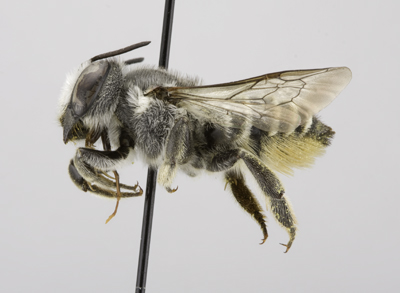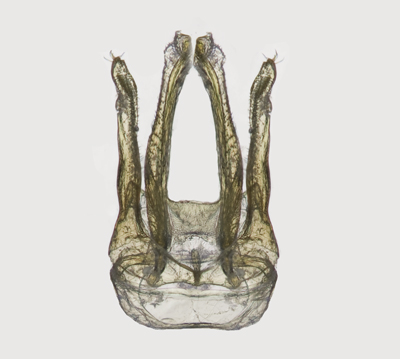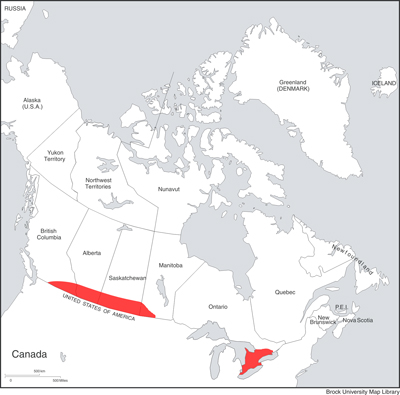
10. Megachile (Litomegachile) lippiae Cockerell, 1900
Megachile lippiae Female |
Megachile lippiae Male |
Megachile cleomis var. lippiae Cockerell, 1900. Ann. Mag. Nat. Hist. (7) 6: 15 (♀, ♂).
Diagnosis.The female of M. lippiae can be recognized by the combination of 4-dentate mandibles with the emargination between inner and 3rd teeth being approximately semicircular (i.e., its greatest depth subequally distant between the two teeth), T6 distinctly concave in lateral view with intermixed short, erect black pubescence, and silvery-white appressed pubescence in apical half, when present, only T5 and T6 with stout, erect, black hairs visible laterally in dorsal view, S6 with scopal hairs entirely black. They are most similar to M. texana, less so to M. brevis, M. coquilletti and M. onobrychidis. Females of M. texana have numerous stout, erect, black hairs laterally on T2‒T6 (visible in dorsal view). Females of M. brevis are generally smaller, and have pale scopal hairs on S6. Females of M. coquilletti and M. onobrychidis have no appressed pale hairs on T6. The male of M. lippiae can be recognized by the combination of 3-dentate mandibles, simple, dark front tarsi, front coxa possessing a small spine, dorsal surface of mesosoma with slight, if any, admixture of black pubescence, T5 with a white apical fascia, T6 with the transverse carina deeply emarginate medially. They are most similar to M. texana. Males of M. texana typically have the dorsal surface of mesosoma and metasoma with a considerable admixture of black pubescence.
FEMALE: Length 12-14 mm.
Head:
Figure M10: Megachile lippiae female mandible |
1) compound eyes slightly convergent below; distance between lateral ocelli and vertex subequal to distance to eyes, 2) clypeal margin straight and simple, 3) mandibles distinctly 4-dentate, incomplete cutting edge between 2nd and 3rd teeth, complete between 3rd and 4th teeth (Figure M10), 4) gena narrower than compound eye (2.5:3), 5) punctures quite deep and distinct, rather fine, well separated across vertex, becoming somewhat more fine, shallow, close and obscure on gena, very close and deep on frons, very fine and densely crowded beneath dense pubescence on paraocular area, separated on clypeus medially, and well separated on supraclypeal area medially, with a large impunctate area, becoming somewhat closer laterally, 6) pubescence whitish, rather short but dense around antennae and paraocular area, more sparse on gena below, becoming somewhat shorter and sparser above, short, erect and mostly black on vertex, on upper margin of eyes, and on frons, 7) F1 about as long as broad, slightly longer than pedicel, slightly shorter in length to remaining flagellomeres, which are longer than broad (3:2), apical segment elongate, about twice as long as broad.
Mesosoma:
1) pubescence white, short but rather dense laterally and posteriorly, more dense around pronotal lobe and base of wing, becoming short and sparse over most of mesoscutum and scutellum, with dark admixture; scutello-mesothoracic suture with fine, pale tomentum, 2) mesoscutum dull, punctures rather fine and close, becoming very close to subrugose anterolaterally and along posterior margin; punctures slightly separated in median area of scutellum, becoming finer and densely crowded laterally and on axilla; pleura very finely and densely punctate above, becoming somewhat more coarsely and distinctly so below; propodeum somewhat smoother, punctures very minute, close and obscure, triangle dull and impunctate, 3) mid and hind basitarsi nearly as broad and about as long as their tibiae, spurs yellowish, 4) tegula dark brown, shining between fine, sparse punctures, with short white pubescence anteriorly, 5) wings subhyaline, faintly clouded in marginal cell, veins brownish-black.
Metasoma:
1) T2-T5 with complete, transverse, basal grooves, basal margin of each distinctly carinate, apical margins rather deeply depressed laterally, 1ess so medially, margins very narrowly hyaline and completely white fasciate, fasciae slightly narrowing medially; T1 with pale, elongate, somewhat sparse pubescence, T2-T5 with discal pubescence short but erect, slightly more elongate medially on disc of T2, and entirely pale, mostly pale on disc of T3 and T4, T4 occassionally with a few elongate black hairs laterally, T5 with pale, erect short hairs basally, becoming black in apical half with more elongate black hairs laterally, T6 with intermixed short, erect black pubescence, and silvery-white appressed pubescence in apical half, laterally with elongate black hairs; punctures fine, very close on T1-T3, becoming more separated on T4 and T5, with shining interspaces ≤ 1 pd; T6 distinctly concave in profile, punctures very fine and densely crowded, 2) S6 with black scopal hairs, with a dense, apical fringe of very short, blackish hairs, scopa otherwise yellowish-white, S5 on some specimens with a few black hairs laterally on apical edge; sterna closely and deeply punctate, very finely so on the more basal sterna, becoming more coarse and sparse on the apical sterna.
MALE: Length 11-13 mm.
Head:
1) compound eyes slightly convergent below; lateral ocelli slightly nearer eyes than margin of vertex (4:5), 2) clypeal margin very slightly produced medially, this area narrowly polished and impunctate, very slightly incurved, 3) mandibles 3-dentate, lower prosess, narrowly triangular, basal in position, 4) gena slightly narrower than compound eye (7:9), 5) punctures deep and distinct, rather coarse and well separated laterally on vertex; becoming finer, closer and more obscure on gena, those on frons close, coarse and contiguous to subrugose, paraocular and supraclypeal areas finely and densely rugose beneath dense pubescence, basal half of clypeus coarsely and closely punctate, punctures separate medially by ≤1 pd, punctures becoming minute and dense toward apical margin, 6) pubescence around antennae and over lower half of face white, dense and quite elongate, more snowy-white and copious on gena below, becoming sparse above, with black hairs intermixed on vertex, 7) F1 about as long as broad and subequal in length to pedicel, shorter than F2 which is longer than broad (3:2), remaining segments slightly longer (3.5:2), apical segment more elongate (4:1.5).
Mesosoma:
1) pubescence short, entirely pale laterally and posteriorly, shorter and more sparse on central area of mesoscutum, 2) punctures of mesoscutum close and rather coarse, very close on scutellum and densely crowded on axilla; pleura with punctures densely crowded, propodeum somewhat more shining, with shallow and rather vague punctures evident, well separated (> 1pd), triangle somewhat dull and impunctate, 3) front coxal spine rather short but well developed, narrowly rounded apically, densely long and pale pubescent posteriorly; spurs yellowish, mid tibial spurs short but well developed; all basitarsi relatively slender and short, 4) tegula reddish-brown, very minutely and quite closely punctate, 5) wings subhyaline, somewhat darkened apically, veins brownish-black.
Metasoma:
1) T1-T5 rather deeply grooved across base, basal margin of groove conspicuously carinate, the margin hyaline, with narrow pale tomentum arising from carina, apical margins of terga narrowly depressed, deeply so toward sides, across entire width of the more apical terga, with entire, white fasciae which are dense laterally, quite narrow or interrupted medially on T2 and T3; discal pubescence pale, elongate, quite erect and conspicuous on T1, shorter on T2-T5, blackish toward apical margin of T5; punctures fine and close on T1 and T2, more distinctly separated on T3 and T4, rather coarse and somewhat elongate apically on T5, apical margins of discs of T4 and T5 considerably overhanging depressed apical rims laterally; T6 quite broadly and densely whitish tomentose above, carina with a deep, semicircular, median emargination, margins on each side subentire, median teeth of apical margin considerably nearer lateral teeth than to each other, 2) S1-S4 exposed, shining, rather sparsely and coarsely punctate on the more basal sterna, becoming more sparse on the more apical sterna, apical margins depressed, yellowish-hyaline, discal pubescence pale and sparse, not hiding the surface, S2 and S3 quite densely pale fasciate.
Genitalia: Figure G10.
|
Figure G10: Megachile lippiae genitalia |
Discussion:
This species is very similar to M. texana, and has previous been considered a synonym of that species (i.e., as M. cleomis; see M. texana). However, in addition to being generally paler, M. lippiae shows 2.59% divergence in CO1 from M. texana. Megachile lippiae, like M. texana, is probably a ground nesting species (Table 1).
Distribution:
From southern ON-BC, though more common in the west (see Map 10). Ivanochko (1979) reported a specimen from NS, but this could not be found. Extensive surveys of bees (see Sheffield 2006; Sheffield et al. 2003; 2008) failed to document its presence in that province.
|
Map 10: Canadian distribution of Megachile lippiae |




